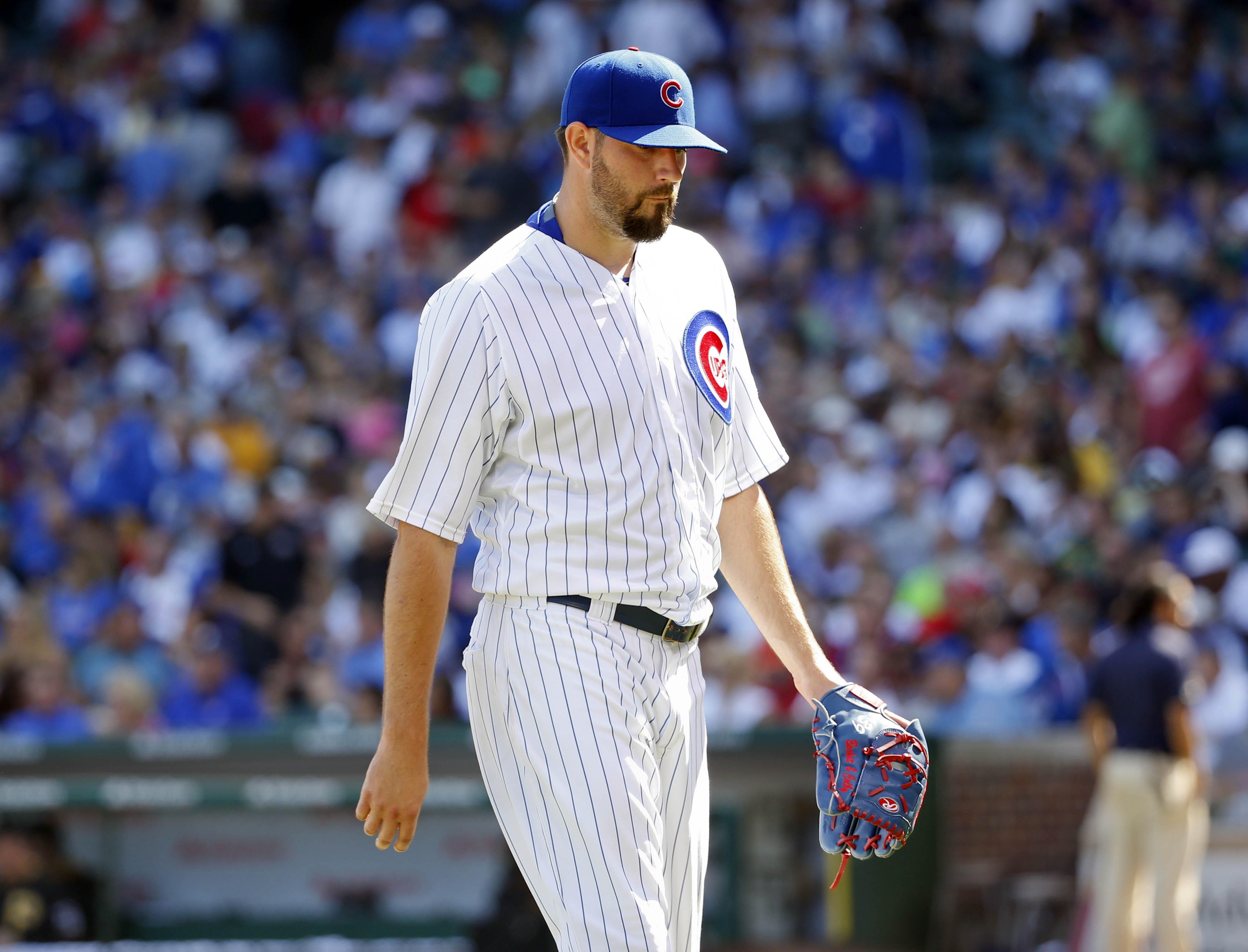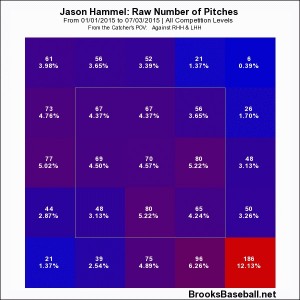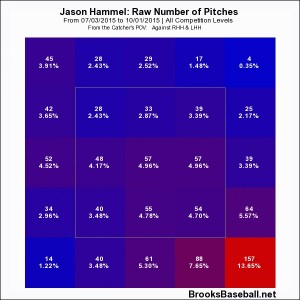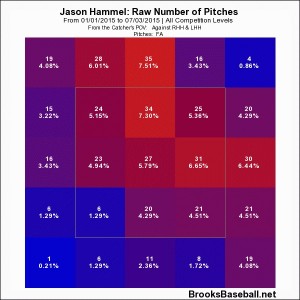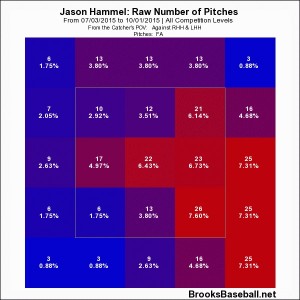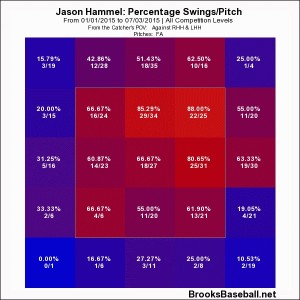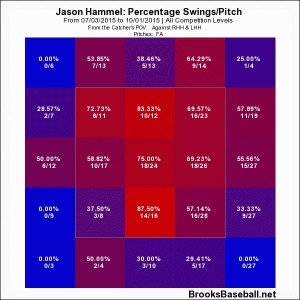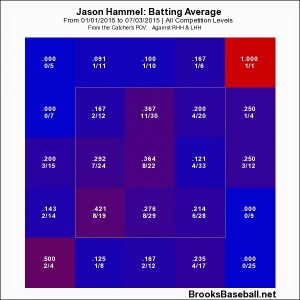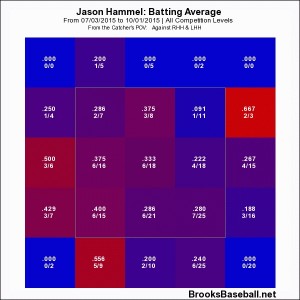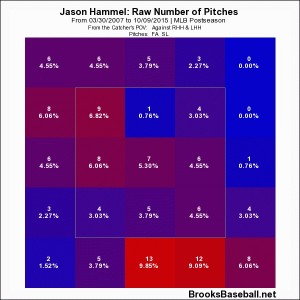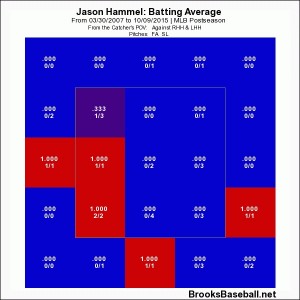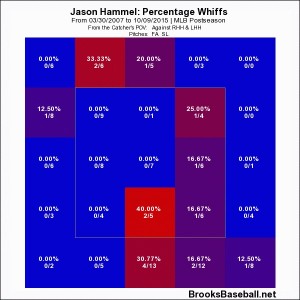In baseball, there are a lot of things that go beyond the numbers. Mechanics. Injury history. State of mind. And a general good old-fashioned feel for the game. While the numbers paint a large portion of the picture, they aren’t the only thing contributing to it. There are exceptions to the sabermetric rule, and I would rather be honest with you than try and put a number on something that simply can’t be quantified, or completely exclude the facets of this game that help us understand why the numbers don’t always give us the full story. There is a human aspect to the game as well. This idea was reaffirmed in my colleague Sahadev Sharma’s recent (and outstanding) piece on Jake Arrieta. Sharma really focuses on all the facts outside of the numbers that contribute to the makeup of a pitcher, in this case Arrieta.
Which brings me to Jason Hammel, who seems to be something of an enigma lately, and who’ll be key to the tail end of this series in St. Louis. While I’m not going to come into this piece telling you that I’m able to directly pinpoint what exact issues Hammel is facing—because I can’t—I can offer some a few thoughts.
We’ve all seen it the last two seasons, first-half Hammel and second-half Hammel. “A tale of two halves,” Hammel called it per a recent piece by CSN’s Patrick Mooney. In fact, BP Wrigleyville’s own Zack Moser looked into the difference between the first and second halves Hammel put together earlier this year on the site. Let’s take a look at those numbers:
| IP | GS | ER | HR | SO | BB | ERA | FIP | Slash Line | |
| First half | 102 | 16 | 33 | 11 | 104 | 18 | 2.89 | 3.13 | .212/.252/.363 |
| Second half | 62 | 13 | 38 | 12 | 62 | 22 | 5.52 | 4.82 | .287/.348/.524 |
The contrast is stark, and though the smaller sample size of the second half can inflate the rate stats in the last three columns, the counting stats aren’t so great either. Hammel’s walks were up over 40 fewer innings, his home run total was up, his earned runs were up, and he only started three fewer games while pitching significantly less.
We saw a similar second-half decline last year after Hammel was traded to Oakland last Fourth of July, along with fellow starter Jeff Samardzija, but again, with no injuries on his record in the 2014 season, this phenomenon wasn’t part of a trend then. Fatigue, some suggested at the time. Pitching in the American League as opposed to the National League, others claimed. But while the AL can be a tougher league to pitch in, Hammel has pitched for both the Rays and Orioles successfully in his career, and so I would say he is well versed in the differences between pitching in the AL and the NL. It’s not as if the Coliseum—where his struggles in 2014 began with Oakland—isn’t a pitcher friendly ballpark.
So what is it then? What is causing Hammel to have this sudden inability to be the effective pitcher we know he can be? As I said, I’m not going to pull a magic solution out of my hat for you, but I will give you a few pieces of insight.
1. Age, Fatigue, and Injury
This is probably the least ‘sexy’ set of issues of them all—but it may nonetheless play a role. In 2012, during his age-29 season, Hammel suffered through multiple knee issues that ultimately resulted in surgery and sidelined him for 83 games. Moreover, Hammel has not pitched over 170 innings since his 2011 season, prior to the surgery, until 2014 and 2015. He could be facing some normal second-half fatigue, as his body may no longer be as able to adapt to pitching this heavy of a workload. Let’s not forget that Hammel will be 34 years old next season. For any baseball player, especially pitchers, this is when you typically start to see your skills decline.
2. Fastball Command, Location
There was a significant change in location on all the pitches Hammel threw in the first half versus those he threw in the second half. As you can see in these heat maps, he was focusing more on throwing high and in to righties in the early goings of the season, before changing his strategy in the second half. At that point, Hammel began to focus more on pitching middle in, as well as low and away to righties.
Now take a look at the drastic difference in location on his fastball. He went from throwing quite a bit high and in to righties, to mostly low and away.
As Moser pointed out in his piece on Hammel, perhaps with his slider being released at the same spot as his fastball—hitters are able to pick up the location on both of Hammel’s key pitches and swing with more of an idea of where the pitch is.
The thing is, hitters’ approach to Hammel’s fastball hasn’t changed as much as his location of the pitch has. Take a look.
It’s a bit different, but the general picture is the same.
Hammel’s overall batting average against has seen a drastic rise as well, as hitters are making quality contact all over the plate now. They’re not letting those pitches off the plate get away.
3. Mechanics and Mindset
The third and final issue I would like to point out is an overall change in Hammel’s mechanics. If you look at some video of Hammel throwing pitches successfully and inducing swings, and then watch video where his command and location are a bit off, you’ll see something of a difference in delivery. When he’s missing his spots, his delivery seems to be more lax and less repeatable. When he’s delivering the ball with authority, his movement shows it. His delivery looks much sharper, and cleaner overall. Maddon has made it obvious that he wastes no time with Hammel when he starts to see signs of trouble, something Hammel has publicly expressed frustration about.
Perhaps what Hammel is failing to see in these situations is that Maddon is attempting to protect his psyche by not letting situations get worse than they are. Should Maddon let Hammel stay in for longer periods of time? Who’s to say that the situation wouldn’t worsen? As Sharma pointed out in his piece on Arrieta, Maddon is very aware of the nuances of every situation with his pitchers. Each player is different, and in Arrieta’s case, Maddon trusts in his pitcher’s ability to continue on with his work without losing confidence in him. Perhaps Maddon doesn’t feel the same way about Hammel, and is protecting him physically and mentally from doing further damage to the situation and himself. Somethings we cannot always see the reason for, but that doesn’t mean that a reason isn’t there.
There are few things Cubs fan can rest assured about moving forward. One is that Hammel is healthy. We haven’t seen a drastic drop in velocity, and he hasn’t left games early due to tightness, soreness or injury. Cubs fans can also be assured that, as demonstrated throughout the second half, Maddon knows when to pull the plug on Hammel before things get out of control. This adds something of a less chaotic element to the idea of Hammel pitching in playoff games. He’s on a short leash, and in October that’s a very good thing. “He’s not injured, and his stuff is good,” Maddon said in a recent piece by Chicago Tribune’s Mark Gonzalez, “We’ve just got to get better location.”
So what does this all mean moving forward? Here’s a look at Hammel’s zone map in the postseason on his two most used pitches, his fastball and his slider.
As he had earlier in the season, Hammel preferred to throw high and in—something we’ve seen him go away from in the later half of the season. Going into October, this could be to Hammel’s benefit. And here’s why:
There is a trend here. That trend being that when Hammel leaves pitches inside to righties, they don’t let him forget about it. As I pointed out earlier, Hammel has laid off throwing in on the hands of righties in the later half of the season, going for more low and away pitches, which could be much to his advantage here.
As we see in Hammel’s whiff map for postseason play, the key to his success has been getting hitters to swing and miss on the high fastballs and the well-located sliders.
Precision will be key for Hammel in this sense, so we must hope that Hammel is able to locate well and induce the swings and misses that get hitters out, even if it’s just in short spans. Whatever struggles Hammel may be facing, they are in all likelihood very fixable, in due time. For now, we can be confident that as we saw in Hammel’s last outing of the regular season, the Cubs can at least get a decent 4-5 innings out of him. Pitchers like Arrieta, and as of late Haren and Hendricks, have been able to give the bullpen adequate rest for situations like this. After all, that’s what longmen and middle relievers are for, right?
Lead photo courtesy Kamil Krzaczynski—USA Today Sports.
